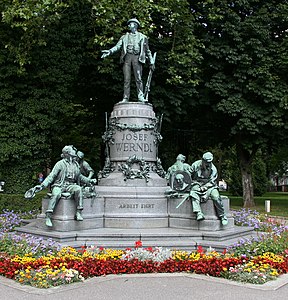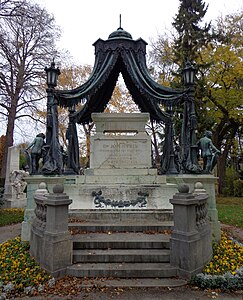art.wikisort.org - Artist
Viktor Oskar Tilgner (25 October 1844 in Pressburg – 16 April 1896 in Vienna) was an Austrian sculptor and medailleur.[1]
This article may be expanded with text translated from the corresponding article in German. (November 2020) Click [show] for important translation instructions.
|


Life
He was the son of Captain Carl Tilgner. The family moved to Vienna when he was a child. His talent was recognized early by the sculptor Franz Schönthaler, who became his first teacher. Then, at the Academy of Fine Arts, he studied under Franz Bauer and Josef Gasser.[1] Later, he was attracted to engraving and worked with the medailleur Joseph Daniel Böhm. One of Tilgner's student's was German sculptor John Walz.[2]
He belonged to the circle of artists around Count Karol Lanckoroński. During the World Exhibition of 1873, he met the French sculptor Gustave Deloye, who strongly influenced his work.[3] The following year, he took a trip to Italy with Hans Makart, whose "realistic academicism" also influenced Tilgner's style. For the last twenty years of his life, he had a large studio in what was originally a greenhouse at the Palais Schwarzenberg[4]
Despite a long-standing heart condition and recurring chest pain, he spent a strenuous day working on his Mozart monument, to get it ready on schedule.[4] He died of a heart attack the next morning. Often considered to be his greatest work, the monument was unveiled a few days after his death. The bulk of his estate was bequeathed to his hometown and is now on display at the Bratislava City Gallery.
Selected major works
- Statue of Leopold V, Duke of Austria at the Heeresgeschichtliches Museum
- Statue of Peter Paul Rubens at the Künstlerhaus
- Statues at the Kunsthistorisches Museum: Christian Daniel Rauch, Peter von Cornelius and Moritz von Schwind.
- Statues at the Naturhistorisches Museum: Alexander von Humboldt, Leopold von Buch, Isaac Newton and Carl Linnaeus.
- Statues at the Austrian Parliament building: Archimedes, Marcus Terentius Varro, Homer and Phidias.
- Statues at the Telfair Academy building: Phidias,[5] Raphael[6] and Rembrandt[7]
- Figures at the Burgtheater: Don Juan, Phaidra, Falstaff, Hanswurst, William Shakespeare, Pedro Calderón de la Barca, Molière, Gotthold Ephraim Lessing, Johann Wolfgang von Goethe, Friedrich Schiller, Friedrich Hebbel, Franz Grillparzer and Karl Felix Halm.
- Monument for Josef Werndl, Steyr
- Monument for Anton Bruckner in the Stadtpark. Due to vandalism, the female figure was removed and replaced with a simple pedestal.
- Monument for Johann Nepomuk Hummel, Bratislava
- Monument for Dr Johann Nepomuk Prix, Wiener Zentralfriedhof
- Monument for Franz Liszt, Ödenburg
- Peter Paul Rubens
- Hummel Monument
- Werndl Monument
- Bruckner Monument, original version
- Carl Linnaeus
- Dr Johann Nepomuk Prix Monument
- Phidias
References
- Fritz Pollak. (1908), "Tilgner, Viktor Oskar", Allgemeine Deutsche Biographie (ADB) (in German), vol. 54, Leipzig: Duncker & Humblot, pp. 703–705
- The Art League Publishing Association (1905). The Artists Year Book. p. 212.
- Ludwig Hevesi: Victor Tilgners ausgewählte Werke. Löwy, Vienna, 1897. (11 pages of text and 72 collotypes)
- † Victor Tilgner (1844–1896). In: Neue Freie Presse, 17 April 1896, p. 05 (Online at ANNO).
- Phidias from SIRIS.
- Raphael from SIRIS.
- Rembrandt from SIRIS.
Further reading
- Gerhardt Kapner: Ringstraßendenkmäler. In: Renate Wagner-Rieger, Die Wiener Ringstraße. Bild einer Epoche. Die Erweiterung der Inneren Stadt Wien unter Kaiser Franz Joseph. Vol.9,1. Steiner, Wiesbaden 1973,
- Maria Pötzl-Malikova: Die Plastik der Ringstraße. Künstlerische Entwicklung 1890–1918. In: Renate Wagner-Rieger, Die Wiener Ringstraße. Bild einer Epoche. Die Erweiterung der Inneren Stadt Wien unter Kaiser Franz Joseph. Vol.9,2. Steiner, Wiesbaden 1976, ISBN 3-515-02391-7.
- Walter Krause: Die Plastik der Ringstraße von der Spätromantik bis zur Wende um 1900. In: Renate Wagner-Rieger: Die Wiener Ringstraße. Bild einer Epoche. Die Erweiterung der Inneren Stadt Wien unter Kaiser Franz Joseph. Vol.9,3. Steiner, Wiesbaden 1980, ISBN 3-515-03288-6.
- Contribution by Walter Krause in: Jane Turner: The Dictionary of Art. Vol.30: Summonte to Tinne. Grove, New York 1996, ISBN 1-884446-00-0, pgs.888–890.
External links
| Wikimedia Commons has media related to Viktor Tilgner. |
- Feuilleton. Victor Tilgner. In: Neue Freie Presse, 19 April 1896, p. 01 (Online at ANNO).
- Victor Tilgner. In: Der Architekt, Year 1896, p. 20 (Hauptteil). (Online bei ANNO).
- Bundesdenkmalamt Österreich: Hauptwerk von Viktor Tilgner gerettet. Wiener Zentralfriedhof. Allegorie der Bildhauerei
- Ludwig Hevesi: Obituary in Wiener Totentanz online
На других языках
[de] Viktor Tilgner
Viktor Oskar Tilgner (* 25. Oktober 1844 in Pressburg; † 16. April 1896 in Wien) war ein österreichischer Bildhauer und Porträtist. Er ist der Hauptvertreter des Neobarock innerhalb der Plastik der Wiener Ringstraße.- [en] Viktor Oskar Tilgner
[fr] Viktor Tilgner
Viktor Oskar Tilgner (né le 25 octobre 1844 à Presbourg, mort le 16 avril 1896 à Vienne) est un sculpteur et portraitiste autrichien. Il est le principal représentant du néo-baroque comme les œuvres du Ring.[ru] Тильгнер, Виктор
Виктор Оскар Тильгнер (нем. Viktor Oskar Tilgner; 25 октября 1844, Пресбург, Австрийская империя — 16 апреля 1896, Вена, Австро-Венгрия) — австрийский скульптор, портретист и медальер. Почётный член Академии изящных искусств Вены.Другой контент может иметь иную лицензию. Перед использованием материалов сайта WikiSort.org внимательно изучите правила лицензирования конкретных элементов наполнения сайта.
WikiSort.org - проект по пересортировке и дополнению контента Википедии






